This was published 8 years ago
Silversea Mediterranean cruise on Silver Spirit: This is what cruising is all about
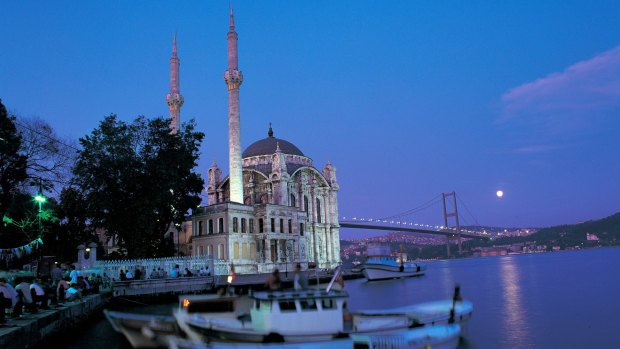
Ortakoy Mosque on the Bosphorus in Istanbul. Credit: Turkish Culture and Tourism Office
Water winks off the swimming pool and the harbour winks back. Ice tinkles in my tall glass. My salad is crispy, prawns baroque pink and fleshy. Seagulls swoop and green ferries chug. Istanbul from the sundeck of Silver Spirit is scruffy and beautiful, highlighted by the exclamation marks of minarets. It's a port to make me linger on the deck after lunch in order to admire its worn wonders.
I lean over the railing and see crew load suitcases and consult clipboards. Taxis honk. Ropes are cast off and the ship nudges away from its berth. As we sail away, the ship's band gets jaunty with jazz and champagne bottles pop. Beyond the rails, Topkapi palace is an Aladdin's vision, and the Blue Mosque soars against a reddening sky. Silver Spirit sails out between Europe and Asia, with its serried ranks of apartment blocks and gleaming neon. Then Istanbul is absorbed into darkness.
It's times like these, sailing out of one of the world's great harbours, that encapsulate what cruising is about. I've visited Istanbul several times but never seen it like this, from mid-harbour and elevated high above the waterline. Now our Silversea cruise is heading down the Turkish coast and onto the Greek islands. Is there a better way to make such a journey? It's the Aegean Sea as it ought to be travelled, as Odysseus did in ancient times – though hopefully without the Cyclops or storms.
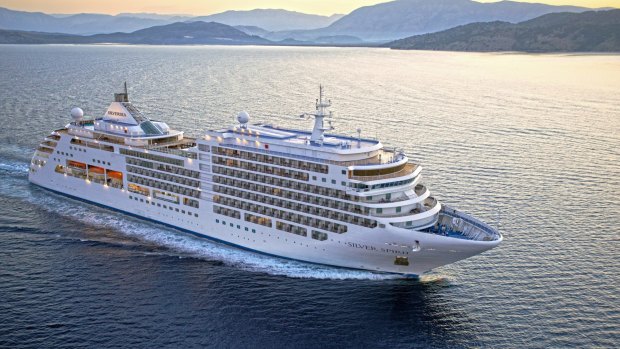
Silversea's Silver Spirit at anchor. Credit: Silversea Cruises
I awake next morning to find we're sliding down Turkey. The land is grey-green and quiet, but the waters provide a flotilla of passing container ships. I've scarcely finished my lunchtime tagliatelle when the ship pulls in at a concrete finger thrusting into a mottled blue sea. Above, Dikili is a curve of apartment blocks on a hot hill. I disembark to find alleyway shops tempting with a kaleidoscope of carpets.
Dikili has been a port for 5000 years, but it's only a footnote to the main event of the afternoon, Pergamum. It first flourished under fabled King Croesus in the sixth century BC. Temples and palaces pile atop a crag that gazes imperiously over the ragged modern town and goat-nibbled plains below. Early German archaeologists, our guide grumbles, carted all the best bits off to a museum in Berlin. Yet it hardly seems to matter: Pergamum gobsmacks in its sheer brute size. Pillars lie in toppled sequences like the vertebrae of outsized dinosaurs, and the marble bones of a vanished empire lie scattered. Views to make me feel like god culminate at the well-preserved, rock-wedged theatre.
Later we head down the acropolis to Asklepion, a famed medical centre founded by the Greeks, but which hit its stride under the Romans in the second century. Emperors and generals came here for mud baths, herbal cures and dream interpretations. Were I here on my own, it might be a half-hour's scramble through indecipherable ruins. Our local Silversea guide Erjan, however, it a witty economic historian who specialises in the classical period ('I think I was an ancient Roman in another life') and regales us with Asklepion's psychiatric treatments and importance of its sacred fountain. 'We now know the water is radioactive, so it might actually have cured certain cancers,' he says.
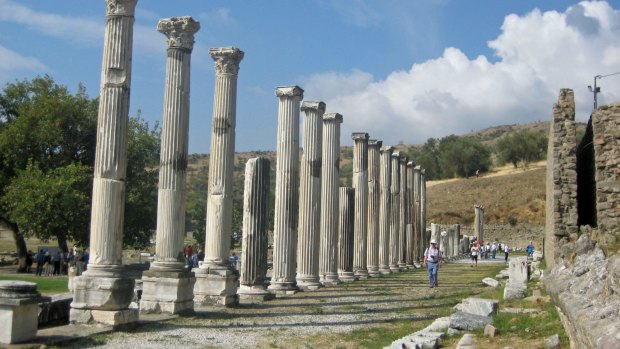
The ruins of the Asklepion medical centre at Pergamum in Turkey. Credit: Brian Johnston
There are more impressive ancient ruins at Ephesus next day. The ship is docked at nearby Kusadasi until 10pm, leaving me plenty of time to amble around this small city as well. Guidebooks are dismissive, referring to it as a cruise-ship port with hillsides sporting apartment blocks for sun-seeking northern Europeans. Yet Kusadasi has a well-kept waterfront where locals perambulate as the red sun fizzles over the Aegean. A castle sits on a harbour promontory, a restored caravanserai provides charm, and alleyways are an agreeable mix of stores selling baklava, hardware, carpets and souvenir trinkets.
Disconcertingly, even my own cruise ship can't muster enthusiasm for our next port further south, Marmaris. "The city has been overwhelmed by boxy concrete development and streets lined with a hundred generically named eateries," sniffs my Silversea handy guide. Yet our arrival, as I'm served omelette and freshly-squeezed orange juice on the deck at Silver Spirit's La Terazza restaurant, unfolds a panorama of forested mountains against a wide blue harbour. We're docked all day and the area is surrounded by fishing villages, gurgling springs and beautiful bays cluttered with fishing boats and yachts in a relaxing counterpoint to big-city Istanbul and ancient ruins.
This cruise has pleasing variety. Next day we're afloat in the sea-sunken caldera of Santorini. I've chosen a highlights tour of this cliff-ringed island, and we're off early to Oia, arriving before the hordes to admire its cliff-clinging whitewashed houses and blue-domed churches. Then we switchback up to Profitas Illias, highest point in the island, and down to Pyrgos for a quick walkabout through whitewashed alleys to a ruined Venetian fort. We cover nearly the whole island, goggling at its bold, elemental geology from every angle, all of it dramatic, and finish in Thira high above our anchored ship. With plenty of free time remaining, I walk the cliff-top pathway towards Imerovigli. Houses are white to make the eyes ache, the caldera's water silver.
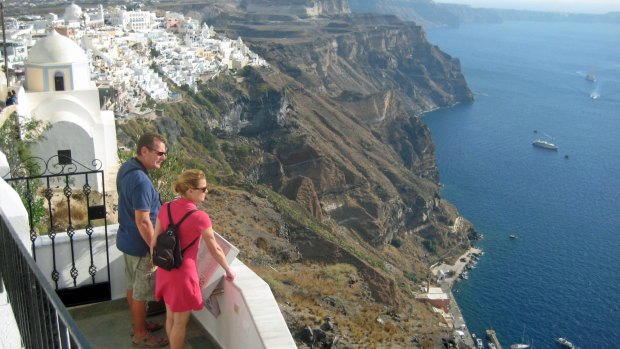
Admiring the sights at Fira in Santorini. Credit: Brian Johnston
Our departure is well timed just before sunset. Silver Spirit drifts past red cliffs whose topping of cubist white buildings blush as clouds pile in pink marshmallows above. The sun sets like a fireball into the sea. The night is sultry and star spangled, perfect for dinner at the open-air grill, where I cook a superb steak on a hot stone at my table.
I mark Santorini down as the highlight of the cruise but next day Rhodes confounds me with its utterly fantastic medieval citadel, ringed by monstrous fortifications and topped by the very epitome of a turreted castle. The inns of the Knights of St John are rough-hewn in blocks of honeyed stone, the streets cobbled, whitewashed homes popping with red geraniums against blue shutters.
Day seven sees us arrive in Crete and dock in Agios Nikolaos, where tavernas and souvenir shops cram around a green lagoon. Greek youngsters gossip in coffee shops and English tourists haggle over plastic Zeus statues. Practically every passenger has signed up for the excursion from here to Knossos, the ruined palace of Minoan Crete. With a half-dozen coaches arriving at the same time, the tour is a crowded, slow-shoe shuffle among sheared-off walls and ruined steps to nowhere. A sophisticated system of drains and architecture is interesting, but much of the commentary seems pure speculation. I'm strangely disappointed by what I've always imagined is one of the highlights of the Mediterranean world.
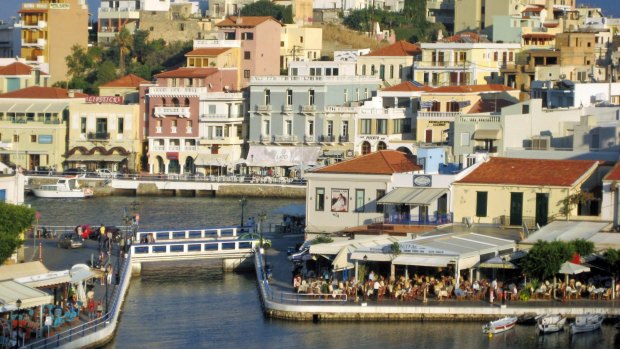
Port town of Agios Nikolaos in Crete. Credit: Brian Johnston
Next day we're scheduled for Mykonos, but stormy weather prevents our visit, since passengers have to be tendered ashore, the quay being too small for our ship. It's disappointing that we miss one of Greece's most celebrated islands, but our next destination Nafplion is too splendid to grumble for long. Nafplion was briefly the capital of newly independent Greece and its first king was sworn in here in 1834. Many gracious neoclassical buildings date from its 15 minutes of fame, and the town is pretty with bougainvillea and marble flagstones. Cafes line the harbour front and prickly pears tumble down a looming crag topped by a whopping Venetian castle. I stagger up a heart-banging set of steps and arrive for a heavenly panorama of blue sea, hills and brown-tiled rooftops.
Silver Spirit departs just before dinner, the Peloponnese a smudge of blue hills and the bay silvery in the late light. I tuck into linguine with pesto and green beans, followed by lime-marinated king scallops. Nafplion's fortress is a receding black bulk above the light-twinkled town, our final destination Athens lies ahead and I've fallen in love with cruising all over again.
TRIP NOTES
MORE INFORMATION
GETTING THERE
Emirates flies from Sydney and Melbourne to Dubai (14.5hr) with onward connections to Istanbul and Athens (both 4.5 hr). Phone 1300 303 777, see www.emirates.com/au
CRUISING THERE
Silversea's nine-day 'Istanbul to Piraeus' itinerary is priced from $6250pp twin share, including meals, beverages, WiFi and gratuities. There are both paid and included shore excursions. Silver Spirit sails 17 other Mediterranean cruises between April and October 2016, and new flagship Silver Muse starts cruising the Mediterranean in 2017. Phone 1300 306 872. See www.silversea.com.
Brian Johnston was a guest of Silversea. Follow him at facebook.com/writerbrianjohnston
THAT'S THE SPIRIT
Silver Spirit was launched in 2009 and is Silversea's largest ship but, with 540 passengers, is small by cruise standards. Yet it manages generous public spaces that don't feel cramped or crowded, and facilities such as a full-service spa, theatre, casino, swimming pool, several lounges and bars. There are multiple dining venues, including informal and additional-cost specialty (French and Asian) choices.
The biggest luxury on any ship is space, reflected in Silver Spirit's enormous cabins. My cabin had a sitting area that fitted both a sofa and armchair; a good-sized balcony; and the largest bathroom I've enjoyed on any cruise ship, with a full-size bath and separate shower. All cabins have attentive butler service.
Guests on the Turkey-Greece cruise were diverse in age and nationality. Although Americans predominated, half the passengers were British, Australians and an assortment of Europeans, particularly Germans. The atmosphere is rather casual during the day, becoming more dressy in the evenings. There were several formal nights, though not observed in all restaurants. Entertainment leans towards the traditional, such as team trivia, bingo and lectures.
Sign up for the Traveller Deals newsletter
Get exclusive travel deals delivered straight to your inbox. Sign up now.